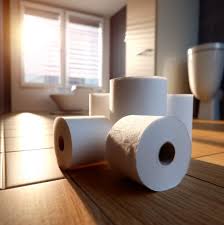Toilet paper, a seemingly simple household item, plays a crucial role in maintaining hygiene and comfort in our daily lives. From its history to its environmental impact, there’s much more to toilet paper than meets the eye. This comprehensive guide will delve into the origins, types, production processes, and environmental considerations surrounding toilet paper, helping you make informed choices for your household.
The History of Toilet Paper
The use of toilet paper dates back to ancient China, where it was first documented during the Tang Dynasty (618-907 AD). However, it wasn’t until the late 19th century that toilet paper as we know it today was developed and marketed in the Western world. In 1857, Joseph Gayetty introduced the first commercially available toilet paper in the United States. This early version was medicated and sold in flat sheets.
The introduction of the perforated roll format in 1890 by the Scott Paper Company revolutionized the industry, making toilet paper more convenient and hygienic. Over the years, innovations such as softer textures, multiple plies, and scented options have further enhanced the toilet paper experience.
Types of Toilet Paper
Toilet paper or Toiletpapir comes in various types, each catering to different preferences and needs. The main categories include:
- Standard Toilet Paper: This is the most common type found in households. It typically comes in single, double, or triple-ply options. The number of plies refers to the layers of paper; more plies generally mean greater softness and strength.
- Recycled Toilet Paper: Made from post-consumer recycled paper, this type is an eco-friendly alternative. It helps reduce the environmental impact by conserving trees and minimizing waste.
- Bamboo Toilet Paper: Bamboo is a sustainable resource that grows quickly without the need for pesticides. Bamboo toilet paper is soft, strong, and biodegradable, making it an excellent choice for environmentally conscious consumers.
- Luxury Toilet Paper: This type often features extra softness, added lotions, and sometimes even scents. It is designed for maximum comfort but tends to be more expensive.
- Septic-Safe Toilet Paper: Ideal for homes with septic systems, this toilet paper breaks down more quickly in water, reducing the risk of clogs and damage to septic tanks.
The Production Process
The production of toilet paper involves several steps, starting with raw materials and ending with the finished product. Here’s a simplified overview of the process:
- Pulping: The primary raw materials for toilet paper are wood pulp, recycled paper, or bamboo. The pulp is created by breaking down the fibers of these materials.
- Bleaching: The pulp is then bleached to achieve the desired whiteness and softness. Some manufacturers use chlorine-free bleaching methods to reduce environmental impact.
- Pressing and Drying: The pulp is spread onto a mesh screen and pressed to remove excess water. It is then dried using heated rollers to form a continuous paper sheet.
- Rolling and Perforating: The paper sheet is wound onto large rolls and then perforated to create individual sheets. These rolls are cut into smaller rolls suitable for consumer use.
- Packaging: Finally, the toilet paper rolls are packaged for distribution. Packaging often includes plastic wrapping, although some companies are moving towards more sustainable options like paper packaging.
Environmental Considerations
Toilet paper production has significant environmental implications, particularly in terms of deforestation and water usage. Here are some key considerations:
- Deforestation: Traditional toilet paper production relies heavily on virgin wood pulp, leading to deforestation and loss of biodiversity. Choosing recycled or bamboo toilet paper can help mitigate this impact.
- Water Usage: The production process consumes large amounts of water, especially during the pulping and bleaching stages. Some manufacturers are implementing water-saving technologies to reduce their footprint.
- Chemical Use: Bleaching agents and other chemicals used in production can harm the environment. Opting for chlorine-free and chemical-free products can minimize this issue.
- Waste Management: Disposing of used toilet paper contributes to landfill waste. Biodegradable options like bamboo toilet paper decompose more quickly and are less harmful to the environment.
Choosing the Right Toilet Paper
Selecting the right toilet paper for your needs involves considering several factors:
- Softness and Strength: These are subjective qualities that depend on personal preference. Generally, higher ply counts offer greater softness and strength.
- Environmental Impact: If sustainability is important to you, opt for recycled or bamboo toilet paper. Look for certifications like FSC (Forest Stewardship Council) to ensure responsible sourcing.
- Septic System Compatibility: If you have a septic system, choose septic-safe toilet paper to avoid potential plumbing issues.
- Cost: Toilet paper prices vary widely. While luxury brands offer added comfort, more affordable options can still provide adequate quality.
- Allergies and Sensitivities: Some people may have sensitivities to certain chemicals or fragrances in toilet paper. Hypoallergenic and unscented options are available for those with allergies.
The Future of Toilet Paper
The toilet paper industry is evolving, with innovations aimed at improving sustainability and user experience. Some trends to watch for include:
- Eco-Friendly Alternatives: The demand for environmentally friendly products is driving the development of new materials and production methods. Biodegradable and compostable toilet paper options are becoming more popular.
- Smart Toilets and Bidets: In some regions, bidets and smart toilets are gaining popularity as alternatives to toilet paper. These devices offer improved hygiene and reduced environmental impact.
- Packaging Innovations: To reduce plastic waste, manufacturers are exploring alternative packaging materials like paper and biodegradable plastics.
- Chemical-Free Options: Consumers are increasingly aware of the potential health risks associated with chemicals in toilet paper. As a result, more brands are offering chlorine-free, fragrance-free, and hypoallergenic products.
Conclusion
Toilet paper is a staple in every household, yet its production and use have far-reaching implications. By understanding the history, types, production processes, and environmental considerations, you can make informed choices that benefit both your family and the planet. Whether you opt for recycled, bamboo, or traditional toilet paper, being mindful of your consumption and its impact can make a significant difference.

